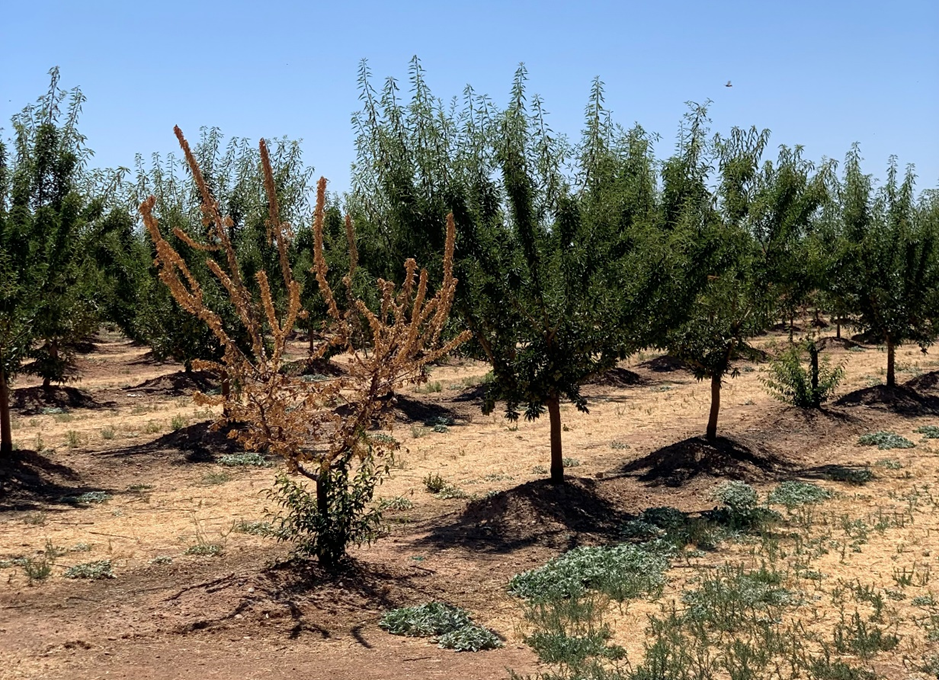Franz Niederholzer, UCCE Farm Advisor, Colusa, Sutter, and Yuba Counites
Diseases caused by Pseudomonas syringae can affect tissue throughout the entire tree, including bacterial blast of flowers, leaves, and shoots as well as bacterial cankers that develop under the bark in cambial and wood tissues of trunks, scaffolds, and branches. The pathogen commonly exists on plant surfaces in an orchard without causing disease, but cold, wet weather can trigger damaging infections. Bacterial canker/blast infections are most damaging, and potentially lethal, in stressed trees. Stress from ring nematodes or root-restricting hardpan predisposes almonds to blast and canker damage.
The wet, cold spring of 2023 promoted widespread Pseudomonas bacterial infections in almond. This pathogen is becoming a consistent problem in cold, wet springs as almond plantings increase across the state.
Currently, there are limited control options for bacterial canker/blast in almonds. The following list outlines factors influencing management practices and decisions.
- Pseudomonas syringae is a damaging pathogen in cold, wet weather.
- The pathogen is ubiquitous and occurs naturally on plant surfaces.
- Infection risk varies with orchard site, rootstock, and variety selection.
- Low spots (sites) are colder and thus, more prone to freeze damage.
- Peach x almond hybrid rootstocks (Hansen, Nickels, Bright’s) are more vulnerable to ring nematode and subsequently to bacterial canker damage than Viking, Lovell, or Guardian rootstocks.
- All almond varieties are susceptible to bacterial canker/blast infection, but some are more so than others. New self-fertile varieties are very susceptible to bacterial blast/canker.
- Antibiotics can significantly reduce bacterial blast at bloom in almond, but none are currently labeled for almond. An effective, research-proven antibiotic (kasugamycin; Kasumin®) was available under Section 18 exception but is not currently labeled for almond.
- Copper resistance is widespread in Pseudomonas syringae bacteria, making copper sprays ineffective.
- Frost protection can help reduce damage.
What can growers do to manage bacterial canker/blast?
- If approved for use, treat with labeled antibiotic (for example kasugamycin; Kasumin®) 1-6 days ahead of forecast freeze. Expect only a week of protection. Note that very cold weather will damage buds even if an antibiotic is applied. Greatest economic benefit should come from bloom treatment.
- If antibiotics are not labeled before bloom 2024, growers have limited options. Spraying copper to control bacterial canker/blast is generally ineffective. Adding mancozeb to copper may overcome resistance. Unfortunately, copper is phytotoxic and may cause leaf damage. Biologicals (Actinovate, Botector, etc) are not registered for blast control in almonds, but if applied for other bloom pathogens may reduce blast damage if applied multiple times (4, 3, 2, and 1 week before bloom).
- Run frost protection irrigation if water is available. This will help reduce both frost damage and blast risk.
- High rates (100 lbs urea/acre) of foliar lo-biuret urea in October reduced bacterial canker growth by more than 90% in UC studies in peach orchards. Lower rates of urea were not tested.
In the long run, recognize bacterial blast and canker risk when selecting rootstocks and varieties for a colder site (valley floor, etc.). Almond variety and rootstock selections in the Sacramento Valley have changed, trending from more tolerant to more sensitive combinations. The traditional almond planting in the Sacramento Valley was Nonpareil and pollinators on Lovell peach rootstock – combinations generally tolerant to bacterial canker/blast. Trees on Marianna 2624 plum rootstock were much more susceptible to bacterial blast than those on Lovell peach. Newer rootstocks with a plum genetic background and newer varieties may also be more vulnerable to damage. Solid plantings of self-fertile varieties on certain newer rootstocks increase the risk of economic loss under cold, wet conditions.
University of California researchers, funded by The Almond Board of California, continue to study Pseudomonas syringae bacterial infections of almond. Updates will be available at The Almond Conference (almonds.com/about-us/programs-and-events/almond-conference) this December.



Leave a Reply